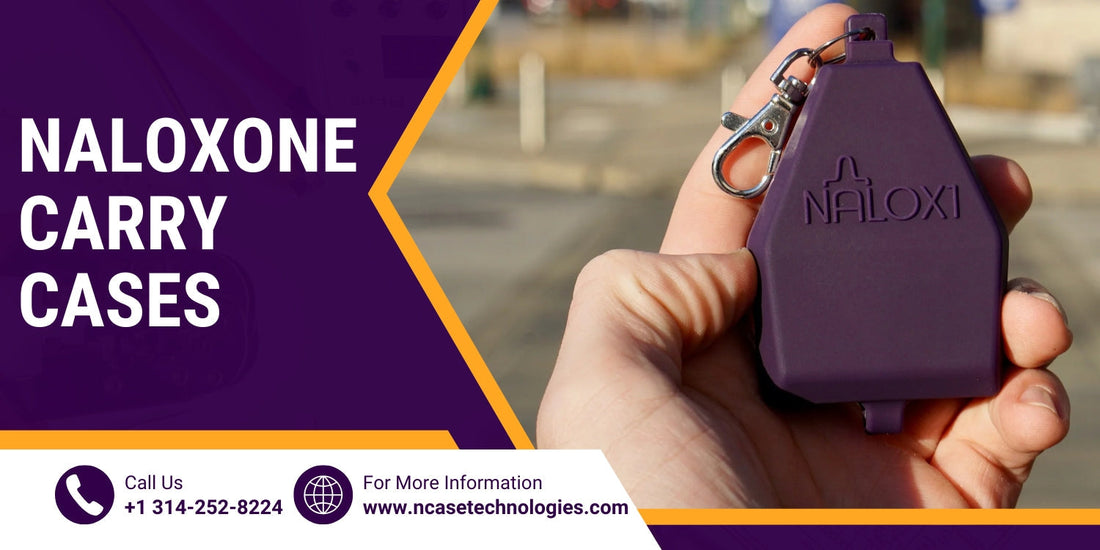
Naloxone Carry Cases: Why They’re Essential for Saving Lives
Share
As the opioid crisis continues to devastate communities, naloxone has emerged as a vital tool in preventing overdose deaths. However, naloxone's life-saving potential is only as good as its accessibility. A naloxone carry case can make the difference between readiness and tragedy. By safeguarding this medication and ensuring it’s readily available, carry cases are an important part of harm reduction efforts.
This article explores the significance of naloxone carry cases, their features, and the data-driven impact of making naloxone accessible in everyday life.
The Overdose Epidemic: A Growing Crisis
According to the Centers for Disease Control and Prevention (CDC), the United States saw over 107,000 drug overdose deaths in 2022 alone, with nearly 75% involving opioids. Synthetic opioids like fentanyl are particularly dangerous, being up to 50 times stronger than heroin and responsible for the sharp increase in overdose fatalities.
Data from the National Institute on Drug Abuse (NIDA) reveals that timely naloxone administration can reverse the effects of opioid overdose in 98% of cases when used correctly. Unfortunately, accessibility remains a significant barrier.
Why Accessibility Matters
Overdose Locations
- 38% of opioid overdoses occur at home, where family or friends are often the first responders.
- Public spaces account for an increasing number of incidents, with bystanders often unprepared to intervene.
Bystander Intervention
A study published in Addiction highlighted that bystanders equipped with naloxone administer it faster than emergency responders, reducing mortality rates significantly. The same study showed that 11% of all naloxone administrations in urban centers were by non-medical personnel.
Challenges in Carrying Naloxone
Despite its availability, barriers to carrying naloxone hinder its widespread use:
- Fragility: Intranasal devices and auto-injectors can be easily damaged without proper protection.
- Temperature Sensitivity: Exposure to temperatures outside the recommended range of 59°F to 77°F can degrade naloxone, reducing its potency.
- Portability: Without a designated storage solution, naloxone can be misplaced or forgotten, rendering it inaccessible in emergencies.
- Stigma: Carrying naloxone can invite judgment or misconceptions, discouraging individuals from having it on hand.
The Role of Naloxone Carry Cases
Naloxone carry cases address these challenges by providing a safe, discreet, and convenient way to store and transport the medication. They empower individuals to be ready for emergencies while minimizing risks.
Key Features of Naloxone Carry Cases
- Damage Protection: Cases shield naloxone from physical harm such as crushing or contamination by dirt and moisture.
- Temperature Regulation: Insulated designs maintain the medication’s stability, even in extreme weather conditions.
- Portability: Compact cases fit easily in pockets, bags, or on keychains, ensuring the medication is always within reach.
- Integrated Kits: Many cases include additional compartments for gloves, alcohol wipes, and instruction cards, creating a complete overdose response kit.
Who Benefits From Carrying Naloxone?
While everyone can benefit from carrying naloxone, certain groups are particularly impactful:
- First Responders: Police officers, firefighters, and EMTs are often the first on the scene of overdoses.
- Healthcare Professionals: Physicians, nurses, and pharmacists frequently interact with at-risk populations.
- Harm Reduction Advocates: Community organizations distribute naloxone as part of their outreach efforts.
- Family Members: Loved ones of individuals using opioids are often the first to witness an overdose.
- Everyday Citizens: Overdose emergencies can occur in any setting, from workplaces to public transit.
Data-Driven Evidence Supporting Naloxone Carry Cases
-
Reduction in Overdose Deaths:
A study in Drug and Alcohol Dependence (2013) showed that communities with naloxone distribution programs experienced a 27% reduction in opioid-related deaths. -
Effectiveness of Layperson Administration:
Research in The Lancet found that 98% of overdose reversals were successful when naloxone was administered by bystanders. -
Impact of Accessibility:
A report from the Harm Reduction Coalition highlighted that individuals who carried naloxone in designated cases were 35% more likely to administer it successfully, citing better preparedness and ease of access.
Practical Tips for Incorporating a Naloxone Carry Case
1. Choose the Right Case
- For outdoor activities, opt for rugged, waterproof designs.
- For professional settings, choose sleek, discreet options that fit easily into bags or pockets.
2. Keep It Visible
- Attach the case to frequently used items like keys or bags to ensure quick access.
3. Inspect Regularly
- Check the condition of the medication and case periodically. Replace expired doses and ensure the device remains functional.
4. Participate in Training
- Many community organizations and health departments offer naloxone training sessions to ensure proper use.
Breaking Down Barriers: Reducing Stigma
Carrying naloxone is an act of compassion and responsibility, yet stigma often discourages individuals from having it on hand. Normalizing the use of naloxone carry cases can help dismantle this stigma, framing it as a tool for public safety rather than a marker of drug use.
Advocacy in Action:
- Public campaigns like “Carry Naloxone, Save Lives” are helping reshape the narrative, emphasizing naloxone as a critical public health resource.
- Testimonials from individuals who have used naloxone in emergencies highlight its life-saving potential and reinforce the importance of accessibility.
Conclusion
Naloxone carry cases are life-saving tools that enhance readiness, protect the medication, and empower individuals to act in emergencies. By addressing practical challenges and breaking down social barriers, these cases amplify naloxone’s impact in the fight against the opioid epidemic.
As the crisis continues, carrying naloxone in a designated case becomes not just a precaution but a moral imperative. Together, through preparedness and education, we can reduce preventable deaths and create a more compassionate society.
Start making a difference today. Invest in a naloxone carry case and join the movement to save lives. Explore a range of durable, discreet, and reliable options to ensure you’re always prepared.


